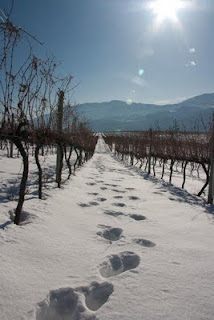So before I start to talk about Tinorn Creek winery again (www.Tinhorn.com), I think it's important to talk about Cabernet Franc; the much planted varietal that plays such a pivotal role in so many great red wine blends.
 |
| Cabernet Franc (courtesy Wikipedia) |
Cabernet Franc is very closely related to Cabernet Sauvignon: in fact, Cab Franc is one of the parents. So what does this mean for flavor, color, aromas? Well of course there are going to be similarities; both are red wine varietals, both are deep in color though Cab Franc will be lighter in pigment (a trick to use in a blind tasting), both have the obvious red berry flavors though Cab Sauv will tend towards blackberry and plum and Cab Franc will tend towards (depending on where it's grown) raspberry and red currant and then for the aromas there are distinctive differences. Cab Franc has a unique vegetal quality which is accentuated by over-cropping and/or underexposure and will be perceived quite often as bell peppers and/or a "stemminess".
Now overcropping is something that any viticulturist can avoid if s/he wants to and is motivated towards. That being said, sometimes there are fiscal reasons for over-cropping and sometimes even viticulturists just don't care about quality - they care for quantity. Underexposure is a different matter altogether.
A winemaker can be motivated to the creation of quality wine, and yet the weather can choose not to co-operate (much like this Summer of 2011 in British Columbia).... by mid-August many winemakers and their vineyard managers are talking about being weeks behind schedule due to excessive cloud cover and mild temperatures. What to do? Well unfortunately, all the skill in the world can't fix something that goes awry in the vineyard.
Which brings us to one of the primary reasons why Cab Franc was planted and continues to be planted in the first place: it buds and ripens an easy week earlier then it's child Cab Sauv. One week may not seem like much difference, but in regions where late rains or hail are a reality, that week may make the difference between a successful harvest and a failure.
And where do we find great plantings of Cab Franc? Almost anywhere winemakers plant Cab Sauv and worry about not reaching phenolic ripeness; the Libournais region of Bordeaux (my much loved AOCs of St Emilion and Pomerol) and the Loire Valley of France, the north-east corner of Italy, parts of California and along the northern border of the United States, British Columbia, the Niagara Peninsula and Prince Edward County regions of Canada and throughout the New World.
So here in beautiful BC we are blessed with almost everything a winemaker could want, with the exception of a lengthy enough summer (in most places) for a winemaker to be able to "properly" cultivate Cab Sauv. What's a winemaker to do? Plant Cab Franc. This is done as insurance for the "Bordeaux-style" blendings for which we have garnered some recognition and, now, as a stand-alone single varietal- sometimes as a late-harvest wine and even as a rosé.
Tinhorn Creek is rather renown in British Columbia (and in Canada) for the quality of it's Cab Franc. To be completely honest though, the acknowledgements come not only for the quality - but for the absolutely reasonable price that they sell it for. Almost anyone these days can make a decent wine, given the right growing conditions... but it is a dying breed the winemaker who consistently sells a good product for a reasonable price.
2009 Tinhorn Creek Cabernet Franc
$19.99 at the winery *** Very Good Value ***
~~ For The Cellar ~~
14.8% ABV
viticulture: 100% from their Diamondback Vineyard on the Black Sage Bench
maturation: 12 months in American oak barrels
awards:
2007 Cabernet Franc
SILVER Pacific Rim International Wine Competition, 2010SILVER Taster’s Guild International Wine Judging, 2010
BRONZE Intervin International Wine Competition, 2009
BRONZE World Value Wine Competition, BTI, 2009
- visual: clear; moderate bruised plum core with substantial cherry rim (slight amount of brick)
- nose: clean; moderate+ intense youthful aromas of red currants, early raspberries, savory herbs, green bell pepper, sweet wood notes
- palate: clean; dry, moderate (well-integrated red currant) acids, moderate+ (slightly green and grippy) tannins, moderate- body, moderate+ intense youthful flavors mimicking the nose with pronounced savory vegetal notes, a long dry finish of red berries, dried mushrooms and sweet wood. Very good balance and structure, long length
- conclusion: whilst this is already a good wine, it still needs some time to develop in bottle and become a great wine. Best (Fall) 2012-2016
- FOOD PAIRINGS: I would work off the lighter body and almost delicate structure and use it much like a Burgundian Pinot Noir, pairing it with a traditional Bourguignon with wild BC mushrooms and local vension... I think the slightly vegetal quality will play well off of venison's gamey-ness, the wild mushrooms pull fungal qualities from the wine and the hint of cream and demi-glace balance the wine's moderate acids
 |
| Tinhorn's Diamondback vineyard |
As always, I look forward to your questions and comments.
CINCIN~!!! SLAINTE~!!! CHEERS~!!!


No comments:
Post a Comment